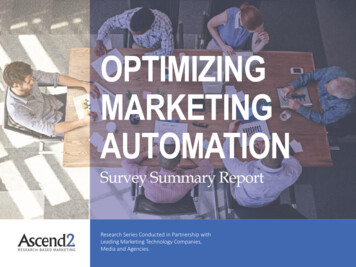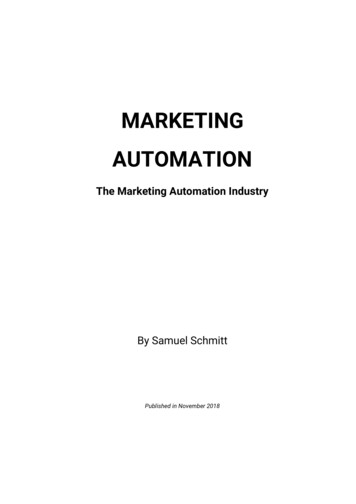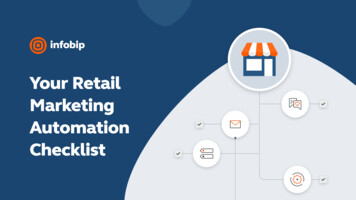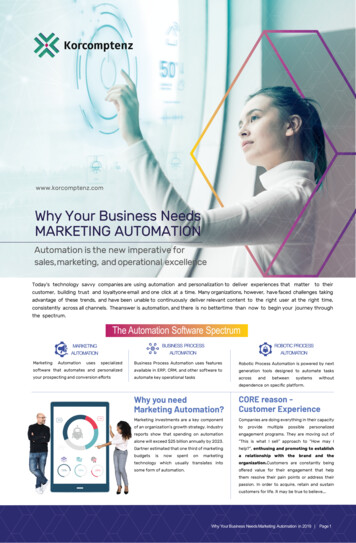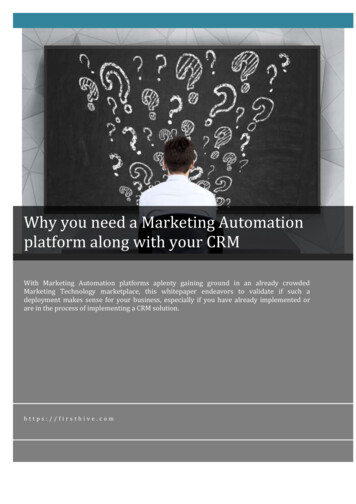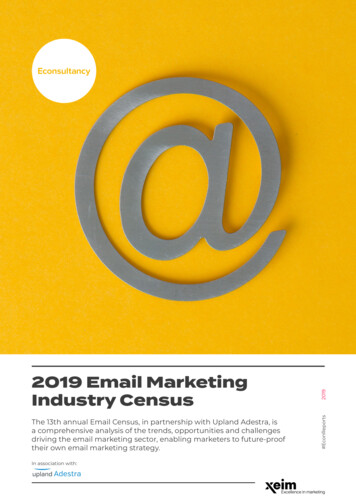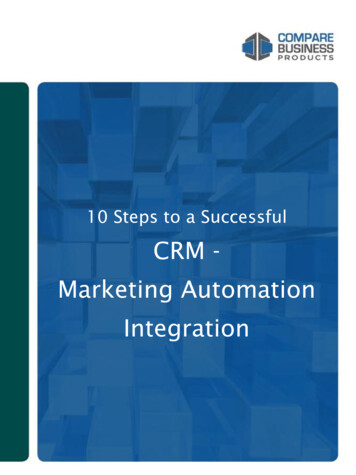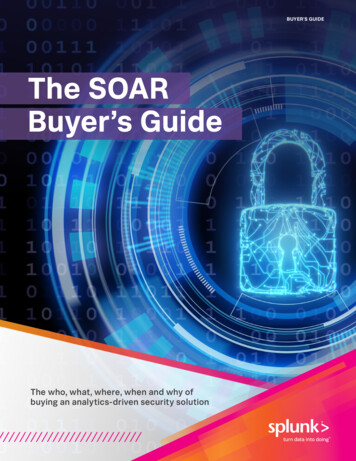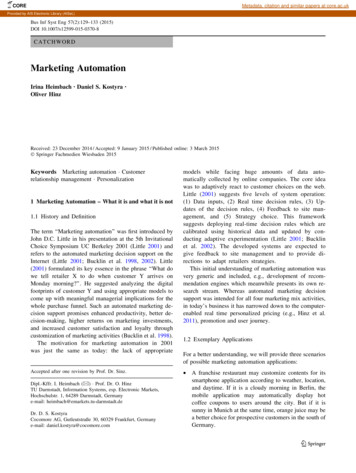
Transcription
COREMetadata, citation and similar papers at core.ac.ukProvided by AIS Electronic Library (AISeL)Bus Inf Syst Eng 57(2):129–133 (2015)DOI 10.1007/s12599-015-0370-8CATCHWORDMarketing AutomationIrina Heimbach Daniel S. KostyraOliver Hinz Received: 23 December 2014 / Accepted: 9 January 2015 / Published online: 3 March 2015 Springer Fachmedien Wiesbaden 2015Keywords Marketing automation Customerrelationship management Personalization1 Marketing Automation – What it is and what it is not1.1 History and DefinitionThe term ‘‘Marketing automation’’ was first introduced byJohn D.C. Little in his presentation at the 5th InvitationalChoice Symposium UC Berkeley 2001 (Little 2001) andrefers to the automated marketing decision support on theInternet (Little 2001; Bucklin et al. 1998, 2002). Little(2001) formulated its key essence in the phrase ‘‘What dowe tell retailer X to do when customer Y arrives onMonday morning?’’. He suggested analyzing the digitalfootprints of customer Y and using appropriate models tocome up with meaningful managerial implications for thewhole purchase funnel. Such an automated marketing decision support promises enhanced productivity, better decision-making, higher returns on marketing investments,and increased customer satisfaction and loyalty throughcustomization of marketing activities (Bucklin et al. 1998).The motivation for marketing automation in 2001was just the same as today: the lack of appropriateAccepted after one revision by Prof. Dr. Sinz.Dipl.-Kffr. I. Heimbach (&) Prof. Dr. O. HinzTU Darmstadt, Information Systems, esp. Electronic Markets,Hochschulstr. 1, 64289 Darmstadt, Germanye-mail: heimbach@emarkets.tu-darmstadt.deDr. D. S. KostyraCocomore AG, Gutleutstraße 30, 60329 Frankfurt, Germanye-mail: daniel.kostyra@cocomore.commodels while facing huge amounts of data automatically collected by online companies. The core ideawas to adaptively react to customer choices on the web.Little (2001) suggests five levels of system operation:(1) Data inputs, (2) Real time decision rules, (3) Updates of the decision rules, (4) Feedback to site management, and (5) Strategy choice. This frameworksuggests deploying real-time decision rules which arecalibrated using historical data and updated by conducting adaptive experimentation (Little 2001; Bucklinet al. 2002). The developed systems are expected togive feedback to site management and to provide directions to adapt retailers strategies.This initial understanding of marketing automation wasvery generic and included, e.g., development of recommendation engines which meanwhile presents its own research stream. Whereas automated marketing decisionsupport was intended for all four marketing mix activities,in today’s business it has narrowed down to the computerenabled real time personalized pricing (e.g., Hinz et al.2011), promotion and user journey.1.2 Exemplary ApplicationsFor a better understanding, we will provide three scenariosof possible marketing automation applications: A franchise restaurant may customize contents for itssmartphone application according to weather, location,and daytime. If it is a cloudy morning in Berlin, themobile application may automatically display hotcoffee coupons to users around the city. But if it issunny in Munich at the same time, orange juice may bea better choice for prospective customers in the south ofGermany.123
130 I. Heimbach et al.: Marketing Automation, Bus Inf Syst Eng 57(2):129–133 (2015)A customer may have bought cinema tickets for aromantic comedy, which features a very famous actorduo. Based on this purchase history and gender, filed inthe account information (in this case: female), anewsletter may be triggered as soon as a new movieis released featuring the male actor in a new film.An online travel agency may customize the displayedoffers according to entered keywords in the searchengine that redirected the user to, e.g., warmer destinations if the user has searched for ‘‘beach holiday’’,and mountain regions if the search phrase was‘‘skiing’’.1.3 Differentiation from Related TermsMarketing automation is often associated with CustomerRelationship Management Systems (CRMS) or mailing listbased promotion campaigns management (e.g., newsletter)and could be confounded with other related fields such asdatabase marketing, interactive marketing, e-marketing,one-to-one marketing (Montgomery and Smith 2009), direct marketing, dialog marketing or email marketing. Theconcept of marketing automation has some principles incommon with these related fields, but also exhibits featuresthat justify its autonomous definition.The core of marketing automation is an automatic‘‘customization’’ or ‘‘personalization’’ of marketing mixactivities and has its roots in the business-to-business(B2B) area. Whereas most B2B marketers manage theircustomers by sales people (using automated processesmanaged in CRMS) who address their clients in personand nurture their interest with customized offers, business-to-consumer (B2C) marketers are limited in applyingthis costly personalized communication. Applying marketing automation transfers key qualities of the B2Bmodel to the B2C area by addressing customers withpersonalized content and customized offers (e.g., customized couponing and discounts). As a result, customersare assumed to show increased involvement and pay moreattention to the brand’s communication due to the enhanced relevance of the provided information (Dijkstra2008). Consequently, companies using marketing automation may enhance their conversion rate, cross- andup-selling, and retention rate.Marketing automation therefore complements areaslike interactive or direct marketing by adding automatedprocesses. It further exceeds disciplines such as CRM oremail marketing, because marketing automation intends toutilize multiple data sources even for unknown users todesign the communication on-the-fly (in real time) for allkind of touch points (e.g., website, smartphone app,email, etc.).1232 Status Quo of Marketing Automation2.1 Marketing Automation ProcessLittle’s (2001) system operation corresponds to the classical marketing management process: evaluate the statusquo situation (data analysis), derive objectives that can befulfilled, define a set of (automated) action to be undertaken, implement them, measure the outcome and if necessary adapt the action plan. Because the evaluation orcalibration phase in the beginning is inevitably linked tocustomer or user information, the availability of data is acritical condition (Level 1, Little 2001). These data mayoriginate from a customer database, but may as well stemfrom tracked user journeys or clickstream data (Bucklinet al. 2002) on the website. Moreover, data remain animportant element beyond the analysis, since all automatedmarketing actions are a direct response to existing, incoming or changing customer/user information. These actions are linked to the information by simple rules: If acustomer/user shows a certain behavior, then initiate a predefined marketing action (Level 2). The major gain lies inthe automated execution of these actions for thousands ofevents once a rule is determined.For this purpose managers may exploit historical customer data, which are then used, e.g., to create customersegments based on interests (observable through purchasebehavior or click-paths on the website), response to directcommunication (e.g., newsletter) or demographics (e.g.,age). Managers draw insights from these segments (e.g.,segment X is interested in category Y) and schedule rulesfor future marketing actions (e.g., send customized offersevery month) dependent on the pursued objective (e.g.,increase sales). Apart from that, marketing automation canalso be applied whenever current user behavior is observable, e.g., an unknown user has been passed to the websiteby a referral. Equal (tracked) events in the past may haveshown that a certain marketing action could be advantageous in this situation, e.g., a customized landing page (i.e.,first page after a user follows an external link).However, even the learning process itself can be automated to some extent (Level 3). If for example a finitenumber of options is applicable (e.g., background color),then marketing automation software is able to apply theseoptions randomly and successively favor the objectivemaximizing alternative (e.g., blue background reduces thenumber of immediate drop-outs). This optimization processand the performance of the above-mentioned rules can bemonitored and adjusted by the manager at any time (Level4). Figure 1 depicts the general process of marketingautomation.Finally, there are also marketing processes, which do notnecessarily rest upon greater insights or optimization
I. Heimbach et al.: Marketing Automation, Bus Inf Syst Eng 57(2):129–133 (2015)131Fig. 1 General framework of marketing automationprocedures but still enhance customer utility (e.g., automated welcome email). For such functionalities marketingautomation is simply an enabler or cost-safer.In general, two questions capture the variety marketingautomation provides: What is customized? And whichtrigger is implemented?The first question focuses on the object and medium.Marketing automation can be used to customize content,structures or the attributes of an offer. In addition, one canautomatically customize an email and other communication channels (e.g., smartphone app) or a landing page andwebpages beyond that. Even traditional (offline) channelscould be improved by marketing automation (e.g., backsideof a theatre ticket).The second question focuses on the trigger. One canadapt content as a function of technical facts like time(elapsed time or time of day), date, IP address (for locationbased marketing), device or browser. It is also possible touse individual information like entered keywords in asearch engine, purchase history, previous or currentbrowsing behavior or account information (i.e.,demographics).2.2 RequirementsFirst, well-conceived data storage is necessary to systematically collect and analyze data on customer and userbehavior. Second, software for rule creation and executiondoes the trick. Many software providers offer a combination of data analysis and execution tools whereby the rangeof functionalities varies a lot. Third, although mostsoftware has an intuitive user interface and does not requirea technological background, expertise in both professions(computer science and marketing) will pay off. Marketingautomation lies thus in the heart of Business and Information Systems Engineering (BISE).2.3 Matching Business ModelsThe applied business model (Veit et al. 2014) affects therelationship between a customer and a firm. As a resultsome companies have a greater incentive to implementmarketing automation processes than others. The potentialgains a momentum with the number of online customersand sales, follow-up purchases, products & brands, communication channels and competitors. For this reason, online retailers are in general more interested in marketingautomation than companies without an online shop. Nevertheless, marketing automation does provide several advantages to them as well. The success of every instance ofcustomer relationship management or a customized userjourney is conditional to the efficiency and creativity ofapplied marketing automation. Hence, customized marketing actions are more and more replacing one-fits-allsolutions in all industries.3 Importance for Business and Information SystemsEngineering ResearchAs an interdisciplinary subject, marketing automation requires the integration of different kinds of knowledge and123
132I. Heimbach et al.: Marketing Automation, Bus Inf Syst Eng 57(2):129–133 (2015)approaches from consumer psychology, marketing, andinformation systems. Systematical integration of IT andmarketing would then be the central activity fields forcompanies. As IT is a core enabler for marketing automation applications, BISE faces a wide variety of research questions. Whereas two decades ago the researchareas concentrated on control system optimization tools, ondesign of databases and recommendation engines (Little2001), the future research might focus on two streams:design of marketing automation software, and the analysisof customer behavior and corresponding identification ofinteresting patterns.real time) for reaching a relevant audience is as challengingas pricing keywords (Skiera and Nabout 2013).Next, due to increased usage of mobile devices the decision rules might become dynamic and adaptive to thecontext. As described in the example of recommendingcoffee in rainy Berlin and orange juice in sunny Munich,historical data on customer behavior may not be sufficient.Finally, a higher level of adaptivity could be reached bydesigning self-learning systems. It may be possible to design software which autonomously adapts the promotioncampaign parameters using the feedback of previouscampaigns.3.1 Design of Marketing Automation Software3.2 Customer Behavior3.1.1 Usage and Integration of New Data SourcesPotential research questions could address customer reactions to marketing automation activities. As personalizationis tightly related to privacy, potential research areas couldinvestigate the optimal level of personalization. On the onehand theory explains that users favor personalized communication and content that matches their tastes. On theother hand, through inappropriate ways or levels of personalization (the company could be perceived as intrusive)the customers could regard their privacy threatened. Thefear of breaching privacy is one of the greatest challengesonline companies face in marketing automation today(Sheehan and Hoy 2000).Modern IT allows inferring consumer preferences and behavior from clickstream and historical purchase behaviordata which enables companies to personalize the customer’s journey and experience on the Internet. Withsteadily evolving computational and storage capacity evenmore data are collected nowadays. Future research areasare then embraced under the umbrella of ‘‘Big data’’ (seeBuhl et al. (2013) for a discussion of this topic). Currentlythe potential that consumers’ digital ‘‘footprints’’ offer hasnot been fully tapped. Business practice calls for validatedmodels and ideas how data can be used in the consumersand the industry’s interest.Further, the development of marketing decision supportmight integrate external data sources, e.g., utilizing userdata from online social networking platforms to generateproduct recommendations in online stores (Gottschlichet al. 2013) or to reach new people who are similar to thecustomer base (e.g., using Facebook’s Look-alike concept,facebook.com/help/164749007013531).As a consequence, the increased amount of user data(Big data) from multiple, heterogeneous sources requiresthe adaptation of the technological infrastructure and thedesign of effective and efficient applications to store,process and apply data and models.3.1.2 Improvement of Data Analysis Tools and Real TimeDecision RulesThe development of software which autonomously recognizes or at least visualizes complex patterns and relationships in data is needed (e.g., Ringel and Skiera 2014).Moreover, future research questions might move aroundthe balance of value and price of target audiences in auction-based display advertising (i.e., Real Time Advertising). In this domain the determination of optimal bids (in123ReferencesBucklin R, Lehmann D, Little J (1998) From decision support todecision automation: a 2020 vision. Mark Lett 9(3):235–246Bucklin RE, Lattin JM, Ansari A, Gupta S, Bell D, Coupey E, LittleJD, Mela C, Montgomery A, Steckel J (2002) Choice and theinternet: From clickstream to research stream. Mark Lett13(3):245–258Buhl HU, Röglinger M, Moser D-KF, Heidemann J (2013) Big data –a fashionable topic with(out) sustainable relevance for researchand practice? Bus Inf Syst Eng 5(2):65–69Dijkstra A (2008) The psychology of tailoring-ingredients in computer – tailored persuasion. Soc Pers Psych Compass 2(2):765–784Gottschlich J, Heimbach I, Hinz O (2013) The value of usersfacebook profile data-generating product recommendations foronline social shopping sites. Europ Conf Inf Syst (ECIS), UtrechtHinz O, Hann I-H, Spann M (2011) Price discrimination ine-commerce? An examination of dynamic pricing in nameyour-own price markets. MIS Q 35(1):81–98Little JD (2001) Marketing automation on the internet. In: UCBerkeley 5th invit choice symp, MontereyMontgomery AL, Smith MD (2009) Prospects for personalization onthe internet. J Interact Mark 23(2):130–137Ringel D, Skiera B (2014) Understanding competition using bigconsumer search data. Paper presented at the 47th Hawaii IntConf Syst Sci (HICSS), Hawaii
I. Heimbach et al.: Marketing Automation, Bus Inf Syst Eng 57(2):129–133 (2015)Sheehan KB, Hoy MG (2000) Dimensions of privacy concern amongonline consumers. J Public Policy and Mark 19(1):62–73Skiera B, Nabout NA (2013) PROSAD: a bidding decision supportsystem for profit optimizing search engine advertising. Mark Sci32(2):213–220133Veit D, Clemons E, Benlian A, Buxmann P, Hess T, Kundisch D,Leimeister JM, Loos P, Spann M (2014) Business models. BusInf Syst Eng 6(1):45–53123
Marketing Automation Irina Heimbach Daniel S. Kostyra Oliver Hinz Received: 23 December 2014/Accepted: 9 January 2015/Published online: 3 March 2015 Springer Fachmedien Wiesbaden 2015 Keywords Marketing automation Customer relationship management Personalization 1 Marketing Automation - What it is and what it is not 1.1 History and .
